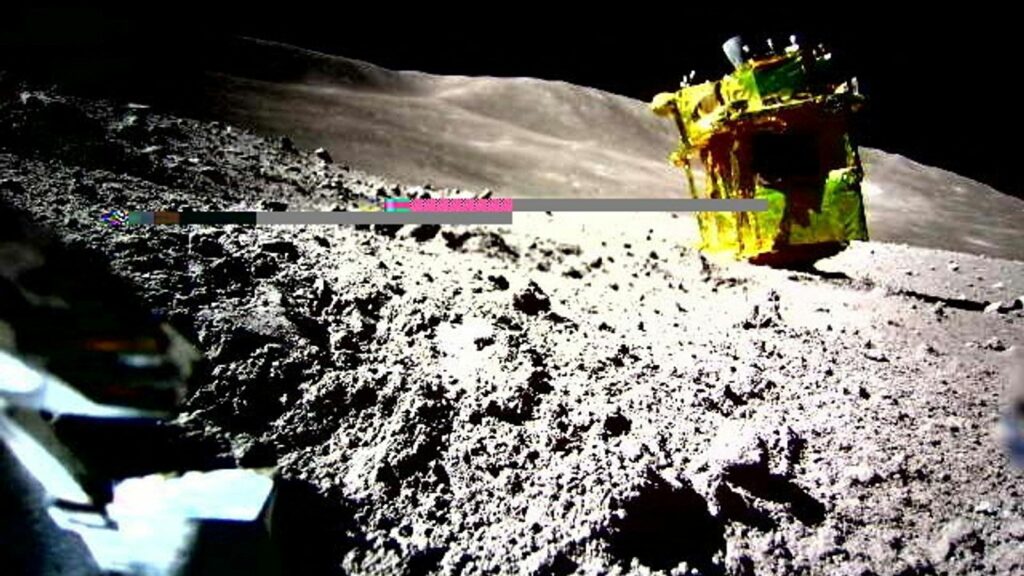Japan may have fluffed spacecraft moon landing – but mission was far from a failure | Science & Tech News

Like a gymnast fluffing the dismount after a perfect routine, it appears a last-minute engine issue caused Japan’s moon lander to touch down on its head rather than its 3D printed feet.
JAXA, Japan’s space agency, released images of the lunar surface, including one showing its SLIM probe’s awkward landing.
Analysis suggests the failure of one of the lander’s two main thrusters just 50 metres above the lunar surface left its autonomous guidance system struggling to control the last moments of the landing.
“Conditions such as the lateral velocity and attitude were outside the design range, and this is thought to have resulted in a different attitude than planned”.
For a lander like SLIM attitude – its orientation on the moon’s surface – is crucial.
Its solar panels are located on the top of the spacecraft. But because it ended up landing on its nose, those panels are pointed away from the sun, leaving the probe starved of power.
As battery power rapidly drained, mission managers were forced to put the lander into hibernation after just three hours on the moon.
An animated image of how Japan’s SLIM should have landed. Pic: JAXA
But the mission was far from a failure.
Working with the scant data they were able to recover from the probe, it’s descent phase was near flawless, and it came to rest just 53 metres from its planned landing spot.
The primary objective of the mission was to prove it could land within a 100m diameter target zone – and it effectively achieved that with one hand tied behind its back.
Read more on Sky News:
Astronomers discover dozens of planets cool enough for life
NASA offers chance to send your name to the moon
Molten ‘blanket’ covering Mars gives new clues about planet
It also deployed its two mini rovers onto the lunar surface. One, a cricket ball-sized crawling robot called LEV-2 took the image looking back at the SLIM lander after touch down.
The other rover LEV-1 – a palm-sized jack-in-the-box type device – used its radio relay to transfer the image from its roving side-kick and send it back to Earth.
LEV-1 also executed a bunny hop manoeuvre on the dusty lunar surface, a locomotion tactic not tried before.
All of which are “firsts” in moon exploration, according to JAXA: “The accomplishment of LEV-1’s leaping movements on the lunar surface, inter-robot communication between LEV-1 and LEV-2, and fully autonomous operations represent groundbreaking achievement.”
Sending an image from the moon back to Earth from such a small pair of rovers is also unprecedented: “This is considered as the world’s smallest and lightest case of direct data transmission from approximately 380,000 kilometres away.”
And despite its stricken state, SLIM and JAXA beat the odds. The success rate of robotic moon landings is less than 50%.
Japan is now only the fifth nation after the former USSR, USA, China and India to pull off a “soft” landing on the moon.
While SLIM is shut down for now, it might not be the last we hear from the lander.
As the moon’s orientation changes and the sun’s rays shift to the west, there’s a chance the probe will get sufficient power from its solar panels to bring it back to life.
Recent Posts
- World of Hyatt and Headspace Launch New Series to Help Travelers Find A Good Night’s Sleep
- Influencers signed up as Abta kicks off pre-peaks promotion
- Peter Island Resort Set for December Debut in the British Virgin Islands
- PM Hotel Group Expands Washington, DC Area Portfolio With Management of Three Hotels
- A snowshoe hike in Bormio, the host of the 2026 Winter Olympics





Recent Comments